![]()
![]()
![]()
Use LEFT and RIGHT arrow keys to navigate between flashcards;
Use UP and DOWN arrow keys to flip the card;
H to show hint;
A reads text to speech;
58 Cards in this Set
- Front
- Back
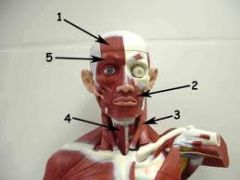
What Is #1?
|
Epicranius Frontalis
-Origin:galea aponeurotica -Insertion:skin of the eyebrows -Action:elevates the eyebrows and wrinkles the forehead |
|

|
Epicranius Occipitalis
-Origin:superior nuchal line -Insertion:galea aponeurotica -Action:elevates the eyebrows and wrinkles the forehead |
|
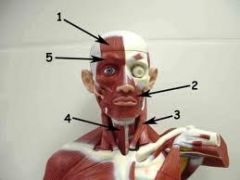
What is #5?
|
Orbicularis Oculi
-Origin:medial orbital margin -Insertion: skin of the lateral cheek; -Action:closes the eyelids |
|

|
Zygomaticus -Origin:upper lateral surface of the zygomatic bone -Insertion:skin of the angle of the mouth -Action:elevates and draws the corner of the mouth laterally |
|

|
Buccinator
-Origin: mandible -Insertion:angle of mouth -Action:pulls the corner of mouth laterally; |
|

|
Orbicularis Oris
-Origin:skin and fascia of lips -Insertion:skin and fascia of the lips -Action:purses the lips |
|
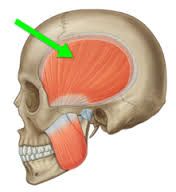
|
Temporalis
-Origin:temporal fossa and the temporal fascia -Insertion:coronoid process of the mandible -Action:elevates the mandible; |
|

|
Masseter
-Origin:zygomatic arch -Insertion:angle of the mandible -Action:elevates the mandible |
|

|
Sternocleidomastoid
-Origin: medial 1/3rd of the clavicle -Insertion:mastoid process -Action: flex the neck |
|

What is #5? |
Pectoralis Minor -Origin:ribs 3-5 -Insertion:coracoid process of the scapula -Action:draws the scapula forward, medialward, and downward |
|
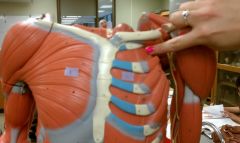
What is #2?
|
External Intercostals
-Origin:lower border of a rib within an intercostal space -Insertion:upper border of the rib below -Action:keeps the intercostal space from blowing out or sucking in during respiration |
|

|
Internal Intercostals -Origin:upper border of a rib -Insertion:lower border of rib above, coursing up and medially -Action:keeps the intercostal space from blowing out or sucking in during respiration |
|

|
Diaphragm
-Origin:xiphoid process -Insertion:central tendon of the diaphragm -Action:pushes the abdominal viscera inferiorly |
|

|
Rectus Abdominis
-Origin:pubis -Insertion:xiphoid process -Action:flexes the trunk |
|

|
External Obliques
-Origin:lower 8 ribs -Insertion:linea alba -Action:flexes the trunk |
|

|
Internal Obliques
-Origin: anterior 2/3 of the iliac crest, -Insertion:linea alba -Action:flexes the trunk |
|

|
Transverse Abdominis
-Origin:lower 6 ribs -Insertion:linea alba -Action:compresses the abdomen |
|
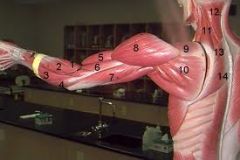
What is #8?
|
Deltoid
-Origin: acromion -Insertion:deltoid tuberosity of the humerus -Action:abducts arm |
|

|
Pectoralis Major
-Origin:medial 1/2 of the clavicle -Insertion:crest of the greater tubercle of the humerus -Action:flexes and adducts the arm, medially rotates the arm |
|

|
Latissimus Dorsi
-Origin:lower 3 or 4 ribs -Insertion:floor of the intertubercular groove -Action:extends the arm and rotates the arm medially |
|

|
Serratus Anterior
-Origin:ribs 1-8 or 9 -Insertion:medial border of the scapula -Action:it draws the scapula forward; |
|
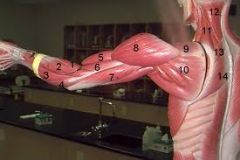
What is #10?
|
Infraspinatus
-Origin:infraspinatous fossa -Insertion:greater tubercle of the humerus -Action:laterally rotates the arm |
|

|
Subscapularis
-Origin: (subscapular fossa) -Insertion:lesser tubercle of the humerus -Action:medially rotates the arm |
|
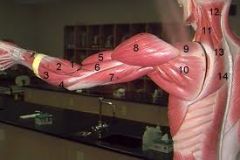
What is #9?
|
Supraspinatus
-Origin:supraspinatous fossa -Insertion:greater tubercle of the humerus (highest facet) -Action:abducts the arm (initiates abduction) |
|

|
Teres Minor
-Origin:upper 2/3 of the lateral border of the scapula -Insertion:greater tubercle of the humerus (lowest facet) -Action:laterally rotates the arm |
|
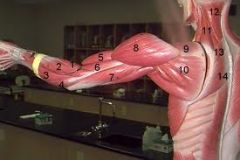
What is #5?
|
Biceps Brachii
-Origin:tip of the coracoid process of the scapula; -Insertion:tuberosity of the radius -Action:supinates |
|

What is #7?
|
Triceps Brachii
-Origin:infraglenoid tubercle of the scapula; -Insertion:olecranon process of the ulna -Action:extends the forearm; |
|
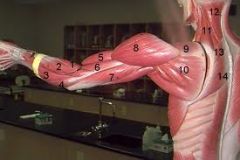
What is #6?
|
Brachialis
-Origin:anterior surface of the lower one-half of the humerus and the associated intermuscular septa -Insertion:coronoid process of the ulna -Action:flexes the forearm |
|
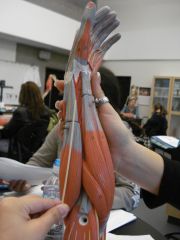
|
Brachioradialis
-Origin:upper two-thirds of the lateral supracondylar ridge of the humerus -Insertion:lateral side of the base of the styloid process of the radius -Action:flexes the elbow |
|

|
Pronator Teres
-Origin:common flexor tendon -Insertion:midpoint of the lateral side of the shaft of the radius -Action:pronates the forearm |
|

|
Flexor Carpi Radialis
-Origin:common flexor tendon from the medial epicondyle of the humerus -Insertion:base of the second and third metacarpals -Action:flexes the wrist, |
|

|
Flexor Carpi Ulnaris
-Origin:common flexor tendon -Insertion:pisiform -Action:flexes wrist |
|

|
Flexor Digitorum Superficialis
-Origin:common flexor tendon -Insertion:pisiform, -Action:flexes wrist, |
|

|
Extensor Carpi Radialis Longus
-Origin:lower one-third of the lateral supracondylar ridge of the humerus -Insertion:dorsum of the second metacarpal bone (base) -Action:extends the wrist; |
|

|
Extensor Digitorum
-Origin:common extensor tendon (lateral epicondyle of the humerus) -Insertion:extensor expansion of digits 2-5 -Action:extends wrist |
|

|
Extensor Carpi Ulnaris
-Origin:common extensor tendon -Insertion:medial side of the base of the 5th metacarpal -Action:extends the wrist; |
|
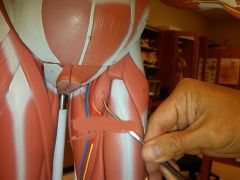
|
Iliopsoas
-Origin:iliac fossa; -Insertion:lesser trochanter of the femur -Action:flexes the thigh; |
|

|
Iliacus
-Origin:ala of sacrum -Insertion:lesser trochanter of the femur -Action:flexes the thigh; |
|
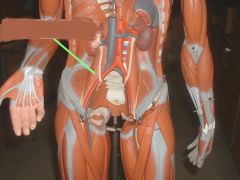
|
Psoas Major
-Origin:bodies and transverse processes of lumbar vertebrae -Insertion:lesser trochanter of femur (with iliacus) via iliopsoas tendon -Action:flexes the thigh |
|

|
Gluteus Maximus
-Origin:posterior gluteal line -Insertion: iliotibial tract -Action:extends the thigh; |
|

|
Gluteus Medius
-Origin:external surface of the ilium -Insertion:greater trochanter of the femur -Action:abducts the femur; |
|

|
Sartorius
-Origin:anterior superior iliac spine -Insertion:medial surface of the tibia (pes anserinus) -Action: flexes leg |
|

|
Tensor Fascia Lata
-Origin anterior superior iliac spine -Insertion:iliotibial tract -Action:flexes the thigh |
|

|
Rectus Femoris
-Origin: anterior inferior iliac spine; -Insertion:patella and tibial tuberosity (via the patellar ligament) -Action:flexes the thigh |
|

|
Vastus Medialis
-Origin: medial lip of the linea aspera -Insertion:patella -Action:extends leg |
|

|
Vastus Intermedius
-Origin:anterior and lateral surface of the femur -Insertion:patella -Action:extends the leg |
|

|
Vastus Lateralis
-Origin: the gluteal tuberosity -Insertion:patella -Action:extends leg |
|

|
Adductor Magnus
-Origin:ischial tuberosity -Insertion:linea aspera of the femur; -Action:extends the femur (ischiocondylar part) |
|
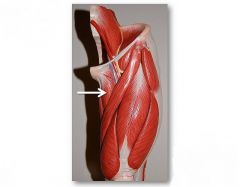
|
Adductor Longus
-Origin:medial portion of the superior pubic ramus -Insertion:linea aspera of the femur -Action:flexes the femur |
|

|
Biceps Femoris
-Origin:ischial tuberosity; -Insertion:head of fibula and lateral condyle of the tibia -Action:, flexes the leg |
|

|
Semimembranosus
-Origin:upper, outer surface of the ischial tuberosity -Insertion:medial condyle of the tibia -Action: flexes the leg |
|

|
Semitendinosus
-Origin:lower, medial surface of ischial tuberosity -Insertion:medial surface of tibia -Action:flexes the leg |
|

|
Gastrocnemius
-Origin:femur -Insertion:dorsum of the calcaneus -Action:flexes leg |
|

|
Soleus
-Origin:soleal line of the tibia -Insertion:dorsum of the calcaneus -Action:plantar flexes the foot |
|

|
Flexor Digitorum Longus
-Origin:middle half of the posterior surface of the tibia -Insertion:bases of the distal phalanges of digits 2-5 -Action: plantar flexes the foot |
|

|
Fibularis (Peroneus) Longus
-Origin:upper two/thirds of the lateral surface of the fibula -Insertion: medial cuneiform -Action:extends (plantar flexes) |
|

|
Tibialis Anterior
-Origin:lateral tibial condyle -Insertion: 1st metatarsal -Action:dorsiflexes the foot |
|

|
Extensor Digitorum Longus
-Origin:lateral condyle of the tibia, -Insertion:dorsum of the lateral 4 toes via extensor expansions -Action:extends the metatarsophalangeal joints of the lateral 4 toes |

